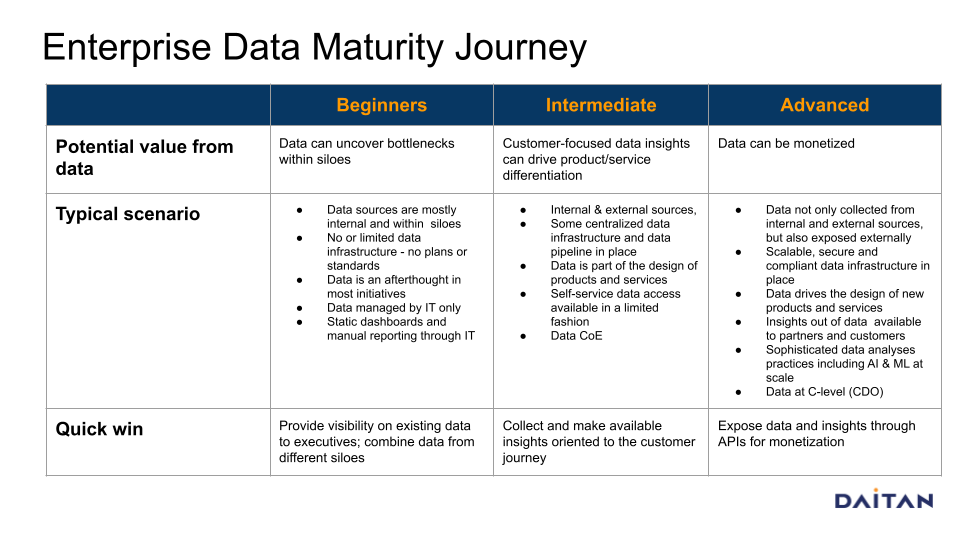
Data remains the lifeblood for the modern enterprise. This rule applies no matter the size of the organization. However, scaling businesses need to take special care to ensure their organization both manages and benefits from their data in an efficient manner. After all, the McKinsey Global Institute predicted 43 trillion gigabytes of data will exist across the globe as of 2020.
Of course, this recent proliferation of data, largely caused by the growth of eCommerce, online video, and social media, makes managing this information difficult for businesses. Still, actionable insights lie within their databases; just waiting to be gleaned. The concept of how well an organization utilizes its own data is known as data maturity.
Achieving data maturity is a critical goal – and a competitive differentiator – for any business that hopes to thrive. So here are a few insights on crafting a data maturity blueprint suitable for any business. Leverage these concepts to ensure your organization takes full advantage of the power contained within its data.
Determining the Data Maturity Level of Your Organization
When determining the data maturity of any business, we typically categorize them into one of three levels: Beginner, Intermediate or Advanced. Depending on their starting level, each company develops a blueprint providing a pathway to reach maturity.
Beginner:
At the Beginner level, organizations tend to use internal data trapped within departmental silos. They also lack a modernized data architecture that fosters security, scalability, and accessibility. In short, these businesses simply use data inefficiently.
Additionally, data accessibility suffers in this environment. Business stakeholders are forced to engage technical resources to craft the necessary reports to analyze existing data. Without proper data management, governance, and visualization tools, the company at this level remains unable to effectively use data for driving actionable insights and critical decision-making.
Common Challenges for Beginner Level Businesses
Business stakeholders often lack the data understanding to accurately determine what data they need for actionable insights. Because of this, the business remains unable to track product and service performance metrics. Thus, they have no way to prioritize system enhancements and new development initiatives.
Companies also have no means to measure a customer’s experience when using their products and services. Additionally, any report generation requires significant technical resources.
Businesses also suffer from a limited understanding of relevant data governance, regulatory restrictions, and data privacy laws.
While the executive team wants to implement more advanced business intelligence or AI and machine learning initiatives, they often lack an understanding of the inherent risk of these projects without first crafting a detailed data plan.
Opportunities to Blueprint a Path to Greater Data Maturity
The executive team and business stakeholders must understand the importance of building a detailed strategy and plan to achieve data maturity. A good initial effort involves conducting a thorough assessment of the company’s current data infrastructure. This approach provides the groundwork for developing a plan while also determining the technologies, resources, and tools needed by the business.
Additionally, identify a focused project to serve as a proof of concept; demonstrating the importance of data to middle management and the executive team. Establishing an initial set of achievable goals based on the data infrastructure assessment serves as the first step toward a full strategic plan to become data mature.
Intermediate:
The intermediate level includes organizations typically using both internal and external data sources. However, their overall data management and utilization remain largely siloed. Ultimately, the organization still lacks a cohesive data strategy to achieve any predetermined goals.
The business also needs a pathway for gleaning actionable information from its data to drive decision-making for the business, product development, and customer experience. While some AI and machine learning initiatives exist, they remain disconnected from any overall data strategy, at many of these types of organizations.
Common Challenges for Intermediate Level Businesses
Too many business stakeholders lack an understanding of how data helps to improve the company’s strategic performance. While some performance measures exist for product usage, the customer journey, and operations, they don’t provide a full 360-degree view of the business. KPIs also need to be developed to provide effective insights that inform the organization’s roadmap to success.
Analyzing customer experience largely limited to web analytics. As a result, the company lacks data on delivering value to customers using the organization’s digital and physical operational processes. Key departments and executives enjoy access to an analytics dashboard, including some automated reporting functionality. However, other reports are fixed-scoped and rarely utilize self-serve and dynamic real-time data.
While a good understanding of regulatory and governance issues exists, the company still requires best practices to develop efficient operational processes. The business boasts some initiatives for AI/Machine Learning projects, but these efforts struggle with data quality issues.
Opportunities to Blueprint a Path to Greater Data Maturity
The executive team and business stakeholders must understand the criticality of formulating a strategic data plan. Therefore, they must commit the required funding and resources for its development as well as subsequent initiatives.
This will allow the company to establish a baseline of their current data infrastructure after another assessment. Subsequently, they craft new goals that lead to additional investments in data infrastructure.
Additionally, officially incorporate significant data-related business intelligence and AI/ML initiatives into the company’s strategic data plan. Completing another AI proof of concept project also demonstrates the value of data analytics to the business.
Advanced:
Businesses boasting an advanced level of data maturity are typically large enterprises with a well-developed strategic data plan including significant input and buy-in from the executive team. Corporate data includes aggregated internal and external sources accessible within and outside the organization.
Importantly, the company’s data infrastructure and related processes are standardized. This approach fosters scalability, as well as data security and regulatory compliance. The enterprise fully understands how to effectively glean data insights to benefit the business.
Common Challenges for Advanced Level Businesses
Management must understand their business requires technical enhancements to create advanced data value streams. Obviously, this modern approach needs to include significant AI and machine learning processing.
Adding technical resources while also improving the data skills of current employees is also critical for achieving project goals. This approach includes developing and retaining a team of specialized data scientists and technology professionals experienced in AI and machine learning.
Another important challenge involves analyzing and determining the underlying business and technology considerations between third-party data management platforms and internal custom development. Remaining compliant with existing data governance and current data privacy regulations needs to be part of this analysis.
Opportunities to Blueprint a Path to Greater Data Maturity
Add the technical and business resources to increase delivery capacity for corporate data projects. One initiative needs to include the design and launch of APIs to expose data and actionable insights to the company’s business units as well as external partners and customers. This approach also includes crafting a data monetization pricing strategy for customers.
 Visualizing a Roadmap to Data Maturity
Visualizing a Roadmap to Data Maturity
This graphic visualizes the path a Beginner level enterprise needs to take to ultimately achieve true data maturity. At the start of this journey, conducting a detailed assessment of the company’s current utilization of data is critical. The results of this assessment inform the planning needed to reach the Intermediate level.
Successfully implementing a pilot project as a proof of concept helps these organizations understand the possibilities of data maturity. Iterative software engineering cycles following the Agile methodology ensure this project’s scalability when deployed into production.
Once at the Intermediate level, a similar assessment and planning effort takes place; plotting a roadmap to the Advanced level. This time, the organization initiates a more complex project at a larger scale, possibly involving multiple data sources and a deeper use of machine learning. The scope of this project might involve re-engineering the organization’s entire data infrastructure. Again an Agile iterative approach ensures a successful outcome.
If your company needs help achieving its data maturity goals, reach out to the team at Encora. As experts in data analytics, AI, and software engineering, partnering with us is the right choice. Schedule some time with us at your earliest convenience. Download our eBook covering the Data-Driven Approach at the following link.


